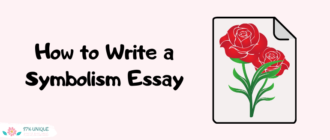
Literature reviews: they are every writer’s least favorite part of writing.
Still, they are a fundamental aspect of scholarly work. They prove that a writer has scoured previous research on a topic, evaluated it, and demonstrated why their own research has merit.
After writing enough of these in grad school, I’ve decided to create a guide to help writers answer the question of “how to write a literature review in a day.”
I’ve also gathered helpful info from other academic and educational sources to further inspire.
After reading this article, you will know how to:
- Find the right, relevant literature.
- Properly organize and catalog works you gather.
- Develop a pattern out of and find gaps in accumulated research.
- Write a stellar review.
Now let’s get down to it.
First Things First: What Is a Literature Review?
A literature review proves that an individual is aware of what other researchers, or “giants” in their field have said on the subject.
As such, lit reviews will consist of literature from other researchers discussing a chosen topic. This literature can come from books, articles, reports, or websites.
As this YouTube video proclaims, academic writing involves “standing on the shoulders of giants.”
But a lit review will not just be a list of academic references. That can fall into plagiarism territory, which you can learn about in this article.
Okay, but What Is Its Purpose?
Basically, they help you prove your point. That’s why I see them as jigsaw puzzles whose pieces are scattered across other scholarly work.

When you are scanning through other works, you are looking for those jigsaw pieces or patterns and gaps in prior research that you will address. When you finish writing, your puzzle will represent what other researchers have missed.
Structure of a Literature Review
Fortunately, they follow the typical format of intro-body-conclusion.
The intro of a lit review will introduce the paper’s topic and the key concepts the writer will explore.

The body is where all the jigsaw puzzles will be addressed, including:
- What have other researchers said about this topic?
- What is your interpretation of their findings?
- How does the prior research add to the topic’s significance?
- Is there a pattern? Or is there a gaping hole in the research?
And the conclusion will wrap up your arguments.
5 Steps to Write a Literature Review in a Day
Thanks to these useful steps you can write a perfect literature review 
1. Find the Relevant Literature
Estimated time: 1 hour
First up is finding a few relevant texts.

My favorite databases are Google Scholar, my library’s database, JSTOR, and Scorpus.
It’s important to distinguish formal vs. informal works, which you can read about here.
I consider effective keywords when searching for sources. These will be words similar to my topic.
2. Read SMARTLY
Estimated time: 1-2 hours
Yes, you’ll need to read, but the trick is to read smartly.

When you type in your keywords and are brought to an article, skim through the abstract and look for:
- The topic
- The key concepts
- The overall findings
- The gap in the research (or the jigsaw pieces)
This will cut down your reading time tremendously!
In this video, the researcher shares a tough truth: “You HAVE to do reading.”
Some people are very restless and it can be difficult for them to focus. Reading smartly can reduce the time you spent studying.
3. Organize Your Findings
Estimated time: 1-2 hours (combined with step 2)
New Zealand ecologist and researcher Francis J. Burdon claims that a “poorly executed” lit review is one that has no “adequate guidance.” Your material has no worth if not organized!
Often PhD candidates will begin their thesis with a literature review, but this can be poorly executed without adequate guidance. A new guide @MethodsEcolEvol looks to be a very useful resource providing a roadmap for scientists at all career stages https://t.co/k1yjQEF9td
— Francis J. Burdon (@frank_burdon) July 1, 2021
While you’re going through articles, pull up either a Microsoft Excel or Google Sheets document to log all of your findings. Include the author and title for all works.

Another good tip is to add additional columns that categorize the findings by relevant keyword, methodology used, and key concept.
The last column for the organized sheet is the “main argument” of the article. Here, summarize the article’s findings in a few sentences.
4. Synthesize!
Estimated time: 2 hours
Now here comes the fun part (at least, to me!). It’s time to synthesize, a fancy word for putting those jigsaw pieces together.
Look over the main arguments and search for any common themes, patterns, contradictions, and weaknesses.

To help you settle on a structure from your findings, literature reviews are usually structured in the following ways:
Chronologically: These are written from when the research began to where it is now.
Thematic: These are organized by common sub themes found in research.
Methodological: These are structured by different academic frameworks used, including different styles of research (i.e., quantitative vs. qualitative).
In this YouTube video the online writing professor, David Taylor, makes a comforting point: “The answers are already out there.”
Everything you need is already written; your job is to put it all together.
5. Write It!
Estimated time: 3+ hours (depending on experience)
All you need to do now is write! I find that crafting a brief outline of which author I’ll mention first and then next helps me start.

In addition, Amina Yonis, a PhD graduate at University of College London, lays out a good format to remember when writing your lit review: background, narrower categories, focus and then hypothesis.
First release of the week!
Here is a snippet of how to write a literature review from my new course lauching next week.
I go through the precise lit review structure, a topic that students notoriously struggle with when writing.
Watch – RT – Savehttps://t.co/GgdR3CODWm pic.twitter.com/UBl90GE9D2
— Amina Yonis (@DrAminaYonis) November 1, 2020
One other thing to remember is to make sure that the transitions in your text flow well. And, of course, you’ll need to spell check and revise for clarity to make sure it’s perfect 
Useful Resources
- How to write a movie review
- Literature review vs. annotated bibliography vs. research paper… What’s the difference?
- American literature & culture: American literature
- List of academic databases and search engines
Conclusion
It’s not so bad, is it?
See? Writing a literature review doesn’t have to be a scary task!
The only other thing to keep in mind with lit reviews is plagiarism, as you will be referencing many other authors’ work.
Don’t worry, though — you can use this handy plagiarism tool here to make sure your content is 100% original.
Take these steps into account pre-writing and you’ll have a stellar review!





